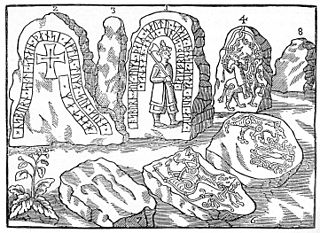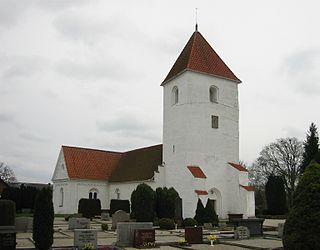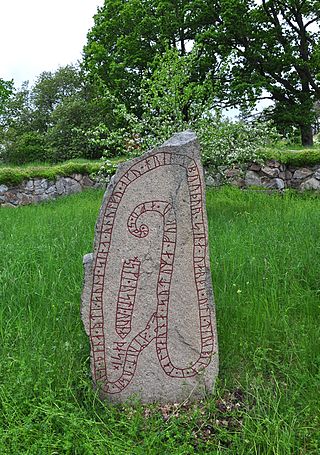The Runestones of Högby are runestones located in the village of Högby in Östergötland, Sweden, but the name Högby runestone usually refers to the notable Ög 81. It is famous for its eloquent epitaph in fornyrðislag for all the five sons of a man. The runestone was found when the church was demolished in 1874. Fragments of some other runestones were found as well. The Rundata project dates them to the late 10th century.

Danish Runic Inscription 66 or DR 66, also known as the Mask stone, is a granite Viking Age memorial runestone that was discovered in Aarhus, Denmark. The inscription features a facial mask and memorializes a man who died in a battle.
The Ingvar runestones is the name of around 26 Varangian Runestones that were raised in commemoration of those who died in the Swedish Viking expedition to the Caspian Sea of Ingvar the Far-Travelled.

The Hunnestad Monument, listed as DR 282 through 286 in the Rundata catalog, was once located at Hunnestad at Marsvinsholm north-west of Ystad, Sweden. It was the largest and most famous of the Viking Age monuments in Scania, and in Denmark, only comparable to the Jelling stones. The monument was destroyed during the end of the 18th century by Eric Ruuth of Marsvinsholm, probably between 1782 and 1786 when the estate was undergoing sweeping modernization, though the monument survived long enough to be documented and depicted.

The Hedeby stones are four runestones from the 10th century found at the town of Hedeby in Northern Germany. This area was part of Denmark during the Viking Age.

The Hällestad Runestones are three runestones located in the walls of Hällestad Church in Torna-Hällestad, about 20 kilometers east of Lund in Skåne, southern Sweden. Their Rundata identifiers are DR 295, 296, and 297. DR 295 is notable because it is held to be raised in memory of a warrior who fell in the legendary Battle of the Fýrisvellir, near Uppsala, Sweden between the Jomsvikings led by Styrbjörn the Strong and Styrbjörn's uncle Eric the Victorious, the king of Sweden, c. 985. The other stones were raised by the same people, and they probably formed a monument together in memory of comrades lost in the battle. The Karlevi Runestone, the Egtved Runestone and the Sjörup Runestone may be connected to them.
The Greece runestones are about 30 runestones containing information related to voyages made by Norsemen to the Byzantine Empire. They were made during the Viking Age until about 1100 and were engraved in the Old Norse language with Scandinavian runes. All the stones have been found in modern-day Sweden, the majority in Uppland and Södermanland. Most were inscribed in memory of members of the Varangian Guard who never returned home, but a few inscriptions mention men who returned with wealth, and a boulder in Ed was engraved on the orders of a former officer of the Guard.
The England runestones are a group of about 30 runestones in Scandinavia which refer to Viking Age voyages to England. They constitute one of the largest groups of runestones that mention voyages to other countries, and they are comparable in number only to the approximately 30 Greece Runestones and the 26 Ingvar Runestones, of which the latter refer to a Viking expedition to the Caspian Sea region. They were engraved in Old Norse with the Younger Futhark.

The Varangian Runestones are runestones in Scandinavia that mention voyages to the East or the Eastern route, or to more specific eastern locations such as Garðaríki in Eastern Europe.
The Viking runestones are runestones that mention Scandinavians who participated in Viking expeditions. This article treats the runestone that refer to people who took part in voyages abroad, in western Europe, and stones that mention men who were Viking warriors and/or died while travelling in the West. However, it is likely that all of them do not mention men who took part in pillaging. The inscriptions were all engraved in Old Norse with the Younger Futhark. The runestones are unevenly distributed in Scandinavia: Denmark has 250 runestones, Norway has 50 while Iceland has none. Sweden has as many as between 1,700 and 2,500 depending on definition. The Swedish district of Uppland has the highest concentration with as many as 1,196 inscriptions in stone, whereas Södermanland is second with 391.
The Baltic area runestones are Viking runestones in memory of men who took part in peaceful or warlike expeditions across the Baltic Sea, where Finland and the Baltic states are presently located.
There were probably two Gunnar's bridge runestones at Kullerstad, which is about one kilometre northeast of Skärblacka, Östergötland County, Sweden, which is in the historic province of Östergötland, where a man named Håkon dedicated a bridge to the memory of his son Gunnar. The second stone was discovered in a church only 500 metres away and is raised in the cemetery. The second stone informs that Håkon raised more than one stone in memory of his son and that the son died vestr or "in the West."

The Fölene Runestones are two Viking Age memorial runestones which are located near the church in Fölene, which is about 2 km (1.2 mi) west of Herrljunga, Västra Götaland County, Sweden, which was in the historic province of Västergötland. The stones are memorials to two men who were described as holding the title drengr.
The Bjärby Runestones are two Viking Age memorial runestones located near Grästorp, Sweden, in Bjärby synod, which was in the historic province of Västergötland. The two stones are memorials to men who held the titles thegn and drengr, and one has a depiction of the hammer of the Norse pagan deity Thor.

The Källby Runestones are two Viking Age memorial runestones located in Källby, Västra Götaland County, Sweden, which was in the historic province of Västergötland.

Västergötland Runic Inscription 90 or Vg 90 is the Rundata listing for a Viking Age memorial runestone located in Torestorp, which is about three kilometers northwest of Gudhem, Västra Götaland County, Sweden, and in the historic province of Västergötland.
The Småland Runic Inscription 48 is a Viking Age runestone engraved in Old Norse with the Younger Futhark runic alphabet in Torp, Forsheda parish, in Värnamo Municipality, Småland, and the style of the runestone is possibly runestone style RAK.
The Södermanland Runic Inscription 49 is a Viking Age runestone engraved in Old Norse with the Younger Futhark runic alphabet. The style of the runestone is a categorized as Fp. It is located in Ene in Nyköping Municipality.

The Södermanland Runic Inscription 333 is a Viking Age runestone engraved in Old Norse with the Younger Futhark runic alphabet. It is located at the abandoned Ärja Church in Strängnäs Municipality. The style of the runestone is a categorized as Fp.

The Södermanland Runic Inscription 360 is a Viking Age runestone engraved in Old Norse with the Younger Futhark runic alphabet. It is located in Bjuddby, Blacksta, in Flen Municipality. The style of the runestone is a categorized as RAK.










